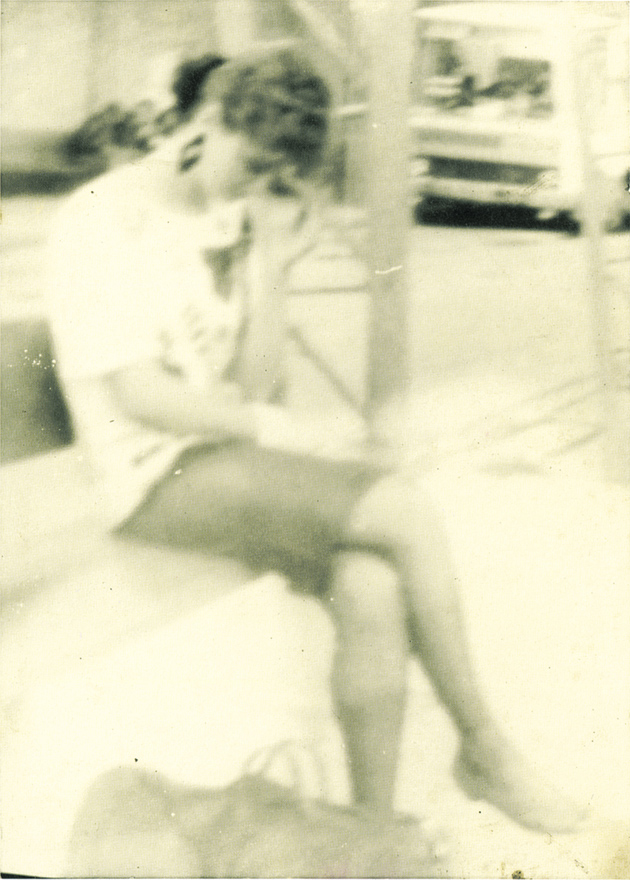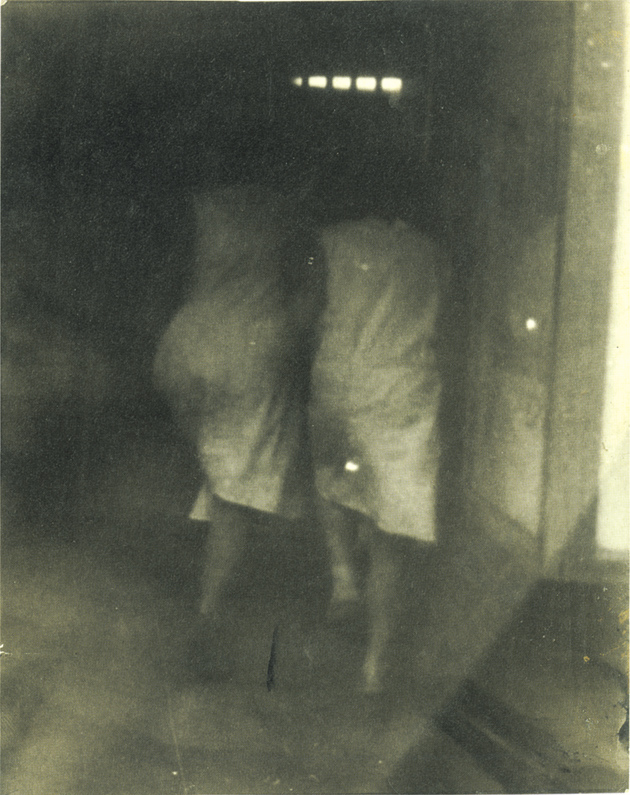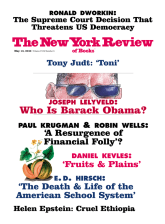
MT Inv. No. 2-197/Foundation Tichý Ocean
Miroslav Tichý: Untitled, n.d. According to Sanford Schwartz, ‘Tichý makes photography a monitor of the nebulous and evanescent—of flashes of beauty in everyday life that go by so quickly we are not sure we have really seen them. His images expand our idea of the medium’s power.’
When Diane Arbus was first becoming widely known, at the time of her retrospective at the Museum of Modern Art in 1972, viewers absorbed her pictures with the knowledge that she had taken her life the year before, and this painful fact intensified their already disturbing, even frightening, nature. At least at the time, the unavoidable fact of Arbus’s biography was a key aspect of why her pictures seemed different from those of most other photographers. Communicating a sense of someone who repeatedly needed to test herself in confrontational situations, they appeared to spring from a level of personal necessity that had little to do with photography itself. Yet in time her ultimate effect was on the art of photography. Her pictures left the impression that the medium had rarely before been so sensitive a recorder of a person’s psychic fears, and in this she altered our sense of what a photographer can do.
Something of Arbus’s indirectly revolutionary power can be felt in the work of Miroslav Tichý. Not that the pictures of the eighty-four-year-old Tichý, who is Czech and is currently the subject of a retrospective at the International Center of Photography in New York, are anything like Arbus’s. In many ways, they are the complete opposite. Arbus bored in on material that most people want to avoid, whereas Tichý’s images, which are almost exclusively of women and at first sight can appear to be so many blurry, technically dubious snapshots, are, in effect, about not boring in.
To a degree that has hardly been felt before, Tichý makes photography a monitor of the nebulous and evanescent—of flashes of beauty in everyday life that go by so quickly we are not sure we have really seen them. He can make us think of Arbus, though, because, like her, he seems to have been driven to make his pictures and to have thought of the camera, in the process, as little more than a handy tool. Yet his images, like her’s, expand our idea of the medium’s power.
Miroslav Tichý was essentially unknown, even in his own country, until 2004, when his pictures turned up in an art fair in Spain. Since then he has understandably become one of the most talked-about figures in photography. The setting of his work is Kyjov, his hometown, a small Moravian city near the Austrian border. There, between roughly the late 1960s and some point in the 1980s—he doesn’t appear to have done any picture-taking since then—he roamed the public places within walking distance of his house, photographing women of all ages, though primarily girls and young women. In some six thousand prints (none dated or titled), he caught his subjects as they went to work, sunbathed, sat on benches waiting for a bus, ran in a park, got into cars, or chatted together. To hear Tichý’s work described, it can sound vaguely disturbing, as if we look at the records of a stalker; and a slightly menacing note does cling to these images, in which his subjects rarely make eye contact with him—they generally don’t know they are being watched—and in which aspects of women’s and girls’ bodies have as much presence as their faces.
In his pictures, we often see young women in bikinis, the garments barely covering them, or his emphasis might be on a woman’s breasts or crotch. Tichý photographed bras in a store window and repeatedly caught women from the rear, their buttocks defined by tight skirts, while a number of images show how women, seen from the waist down, look in heels. And among these photos that were taken in the daylight in Kyjov, there are others that, generally having darker backgrounds yet blending unobtrusively into the flow, present more outwardly sexy and glamorous women. Giving us the impression that we are seeing Kyjov by night, these pictures in all probability were made from Tichý’s photographing magazine spreads, or posters from strip clubs and dance halls, or TV. (The faces of Marilyn Monroe and, possibly, Elizabeth Taylor can be made out in separate shots.)
Yet what Tichý gives us is less salaciousness than the record of a wondering and boyish, if relentless, attraction to women—to the working women and housewives of Kyjov as much as to its sunbathers and the showgirls he snapped on TV. This attraction, in turn, seems no more powerful than the sense of composition underlying these pictures, which are disorientingly classical in their balance and simplicity. The underlying elegance of Tichý’s work keeps taking us by surprise, because his pictures would seem at first to be the essence of haphazardness. The most obvious and, ultimately, distinctive aspect of Tichý’s photography is that his images are blurry. There are pictures where we are not sure at first what we look at. His black-and-white prints (he doesn’t appear to have worked in color) can also be irregularly shaped, curly at the edges, scratched, drawn on, and stained with various dribblings. For some viewers a Tichý will be simply a banged-up and hopelessly out-of-focus photograph.
Advertisement
Tichý worked with cameras he made himself out of scraps—including wood, bottle caps, thread spools, cardboard tubes, found eyeglass lenses, and asphalt used as a binding agent. His cameras were so implausible that most people thought he had no film and was just pretending to take photographs. His printing methods, in addition, seem to have been riskily unorthodox and slapdash. So it is possible that his equipment and techniques are responsible for the hazily bright or overly shadowy, unfocused nature of his exposures. Yet taking thousands of photos that add up to a kind of guide to the varieties of being out of focus suggests that Tichý sought exactly what he was getting.
Going through the current exhibition (or, better, its first-rate accompanying catalog, which expertly reproduces his prints in their varying actual sizes), a viewer can, moreover, develop a keen taste for Tichý’s countless different levels of softly diffuse light. On those rare occasions when his pictures are largely in focus (often views of trees), Tichý suddenly seems like no photographer in particular; his spell evaporates.
He isn’t by any means the first camera artist to explore the possibilities of blurriness. Over a century ago, Alvin Langdon Coburn and Clarence H. White, and later Josef Sudek, the best known of twentieth-century Czech photographers—to take merely three examples—experimented with degrees of clarity and recognizability. But Tichý makes the softly indistinct photograph practically his own invention in that he shows it to be inseparable from what he continually captures: women glimpsed in random and, in dramatic terms, undeveloped moments. In pictures that have been rightly likened to images from sonograms, his subject at times seems to be simply sentience in itself.
Tichý’s work has taken an immediate hold on viewers in good measure because the unusual qualities of his pictures are of a piece with his life story. He appears to have thought of himself all along as a painter and draftsman, and he studied art in Prague after World War II, when he was in his twenties. But the Soviet takeover of Czechoslovakia in 1948, with its transformation of art into the presentation of only narrow, academically approved socialist realist themes, along with two years of compulsory military service, helped send him, by 1950, back to Kyjov—a place less rigidly overseen by the authorities than Prague—for good. In the company of other artists who had left the capital, he continued to paint and draw, and he participated in experimental work in the theater and with photography.
Yet the prospect of being in an important group show, in 1957, deeply unnerved Tichý. He had been treated for mental disorders since adolescence, but this time he had a full-fledged psychotic breakdown and needed to stay in a clinic for over a year. The Tichý who emerged was a far less convivial man. Whether from political, psychiatric, or artistic reasons, he began to turn himself into a walking emblem of a refusal to play by anyone’s rules. He let his hair grow long and had a full beard—in photos from the 1970s he recalls a grungier version of Jeff Bridges in Crazy Heart—and he lived a bit like a renegade and a bum, but also like a street philosopher, a man seeking to divest himself of the comforts of a society whose values he no longer held.
He never washed and wore the same clothes day and night. His coat grew threadbare but, the son of a tailor, he assiduously patched and rethreaded it, turning it into a kind of crawly, curlicued, somewhat alarming item that, he assured people, would have been thought stylish in Paris. And so while Kyjov was a sleepy backwater, the authorities kept their eye on Tichý, hauling him into jail or clinics as a public nuisance, at one point throwing away his coat and cameras and cutting his hair, and even putting him on trial. Over the years, the police settled on bringing him in on May Day and other state occasions, times when they no doubt wanted to remind the local community that they were keeping it safe from ne’er-do-wells; and so regular were the police that Tichý’s mother would ready a little suitcase, packed for him for his stay in jail, just before the expected pickup.
Advertisement
Tichý had long shown an interest in photography, but it wasn’t until sometime in the 1960s that he thought to take it up seriously. His subject in his paintings and drawings had been women, seen as the occasion for studies of form and color (his nonphotographic work is not part of the show, though some of it is reproduced in the catalog). That he saw his photographs as substitute paintings is indicated by his occasionally drawing over his prints, clarifying, say, the shape of a woman’s leg or the edge of a bikini, and by his matting his photos with odd bits of paper (some have TV listings on the back). He would then sometimes draw over these mats, making them resemble picture frames (additions that to me are unnecessary and obtrusive).
By the time Tichý became immersed in photography his character as a refusenik was highly developed. He lived with barely any running water, made most things he needed by hand from whatever scraps he could find, and lived unobjectingly with vermin, ungovernable dust, and a mighty stench. He treated his many photos with the same brusque indifference he had thrown about his paintings and drawings, and the idea of exhibiting, let alone selling, any of his artwork was unthinkable to him. Tichý the person is very present at the ICP, where some of his books, encased in dust, and a lamp he fashioned are on display along with vitrines full of his handmade cameras and other photographic supplies. Darkened by grime and evoking the tools of a mad scientist or hobbyist, they are somewhat ghoulish, a feeling that is mitigated a bit by Tichý himself, the subject of a documentary about him, playing regularly at the exhibition, called Tarzan Retired.
The title is how Tichý has referred to himself, and the film, from 2004, is by Roman Buxbaum, an old family friend and native of Kyjov. Buxbaum is a psychiatrist and the author of a lengthy biographical essay in the ICP catalog, which seemingly presents all the salient facts about Tichý’s life. It was Buxbaum who over many years attended to the artist’s welfare without his knowing about it and who managed to get Tichý’s photographs to a safe place. Buxbaum was responsible for making them known to the late Harald Szeemann, an art-show organizer who, exhibiting them six years ago in Seville, brought Tichý to the world’s attention.
The character we encounter in Tarzan Retired is as elusive as his photographs. (The film’s very title, which evokes a loner who lives by his own jungle rules and is not fully domesticated, yet at the same time is retired, or out of the fray, catches the man’s contradictoriness.) In the movie, we can wonder if Tichý is altogether sane, or an actor pulling our leg, or simply an old coot—a now irascible, now beatific fellow who, when he watches himself in a rare interview he has done, which is being played on someone’s computer, chuckles appreciatively at his remarks, as if to say, “My, that’s a good one.”
As Buxbaum and other writers have noted, Tichý’s photographs, and his very endeavor as a street photographer, can’t readily be categorized. To a degree, his life and his work together represent a political statement. In his making himself an eyesore as he walked around Kyjov, in his rejection of modern hygiene and technology—and in his creating, as an artist, a kind of monument to the inconsequential, the apolitical, the possibly naughty, and the seemingly slipshod—he turned upside down much of the social program his country’s Communist leaders wanted to see in place. But then a case could be made that by going out every day wearing his keep-your-distance uniform and carrying cameras that were as funky and prop-like as his attire, Tichý was as much a performance artist as a symbol of political protest. In this scenario, one might judge his photographs to be merely souvenirs of his act.
Yet there is also an understandable pull to see Tichý as an outsider artist. His history of mental illness and his largely removing himself from society certainly make one think of him in this light. So, too, does the way he fashioned so many aspects of his artistic endeavor from odd materials laying around, which recalls the canny and frugal way that Martín Ramírez, for example, who was kept for years in hospitals in California, operated when he made his drawings. The startling profusion of Tichý’s output, furthermore, and his seemingly compulsive need to revisit the same circumscribed subject day after day recall the approach of Ramírez and of the Swiss Adolf Wölffli, who also did all his artwork after being placed in an institution.
In the pages of the show’s catalog, though, our concerns with Tichý the person and with how to categorize him fade, and we are left with the unlikely comeliness and the unlikely formal inventiveness of his world. Much like the way he turns the everyday women of his small Czech city into fashion models of a sort, his pictures, after a while, don’t seem merely blurry. They have the presence instead of so many sensuous orchestrations of closely related grays, white, and black. Like Seurat’s conté crayon drawings, Tichý’s prints convey the feeling that light and shadow—or is it smoke, clouds, and vapor?—have momentarily coalesced to become this or that image. Forming a treasure trove of changeability and indefiniteness, they make photography feel like painting and drawing combined and, no less remarkably, transform Kyjov into a kind of Paris.




